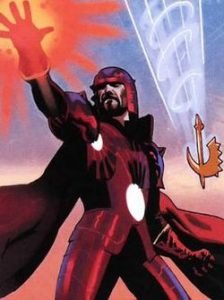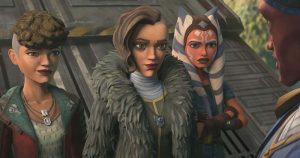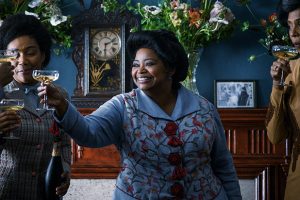Last night, I had the chance to watch Avengers: Endgame again for the first time in a while. As on previous rewatches of the film, I found myself appreciating most of the first act of the movie (where, SPOILER ALERT I GUESS?, the Avengers kill Thanos), and most of the third act (where the Avengers kill Thanos a second time). I even liked a lot of stuff in my least-favorite part of the movie, that troublesome second act that has the team split up across different timelines and try to steal Infinity Stones from history.

But I still cringed at the absolute worst part of Avengers: Endgame – the scene in which Natasha Romanoff, the legendary Black Widow, sacrifices both her life and years of character development in exchange for the mysterious Soul Stone, willingly leaping from that accursed cliff on the godforsaken planet of Vormir to her very certain death. Cue the outrage. Natasha Romanoff, Marvel’s first (and for a long time, only) woman Avenger, was sacrificed in much the same way as another woman a year earlier: Gamora, who was tossed from the cliff by her own father. As womens’ bodies continue to pile up at the foot of that stupid cliff, fans (and especially, female fans) asked Marvel one simple favor: could you please stop fridging women?
Natasha Romanoff’s death is doubly infuriating because it came just before her long-awaited solo movie, Black Widow, which is supposed to explore an adventure in her past, before the events of Avengers: Endgame. But many are still clinging to a desperate hope that the Widow is still somewhere out there, either alive on earth or fighting to get back home. So let’s take a look at a couple ways Natasha could come back to life in the Marvel Cinematic Universe.
5: It Wasn’t Really Her.

This theory is a bit preposterous, but still worth noting: the idea is that Natasha Romanoff’s “sister”, Yelena Belova, who will make her debut in the Black Widow film, actually traded identities with Natasha before Avengers: Infinity War, or at some other point before Avengers: Endgame. There’s a little bit of evidence that supports this: Natasha wearing Yelena Belova’s jacket in Infinity War; a shot from a recent Black Widow trailer that shows Yelena Belova on a surgical table with a strange scar around her forehead, as if her face had been removed or changed. This option is undoubtedly the least appealing, not only because it would mean that the rest of Natasha’s awesome character beats in Endgame weren’t her own, but because this only changes the identity of the woman victim. As Infinity War Captain America would say: “We don’t trade lives.” Nonetheless, expect the super-spy sisters to swap identities frequently in the Black Widow film.
4: Multiverse Shenanigans.

As I mentioned previously, Gamora was the first person to lose her life on Vormir – but she has since returned, thanks to the time heist in Avengers: Endgame. Coincidentally, it was when Black Widow, Nebula, Hawkeye and War Machine traveled back to 2014 to retrieve the Power and Soul Stones that a 2014 version of Gamora was able to slip through into the present Marvel timeline, along with the 2014 Nebula and Thanos. If the Avengers wanted to bring Natasha back, they could simply find a version of her from another timeline – but that poses a whole bunch of other problems.
3: Bruce Resurrected Her.

One of the plot-lines left over from Avengers: Age Of Ultron that went nowhere was the love story between Natasha Romanoff and Bruce Banner a.k.a. The Hulk. The two characters both regarded themselves as “monsters” (let’s not even get into the reasons why), and bonded over that. But after Bruce went missing for two years and the Avengers films switched directors, that story was mostly left unfinished. Except for the fact that, when Bruce Banner finally got his hands on a fully-operational Infinity Gauntlet at the end of Endgame and snapped his fingers to bring back the people that Thanos had dusted, he also tried to bring back Natasha. This is only mentioned in a throwaway line in the film’s final few minutes, but it’s still intriguing – could Bruce have been successful? How would he know? Natasha would presumably be resurrected on Vormir where she died, meaning she’d have to find her own way home.
2: Captain America Came To Bargain.

At the end of Avengers: Endgame, Captain America takes it upon himself to go back in time and return all the Infinity Stones the Avengers had taken from time. The Space Stone went back to New Jersey, the Time Stone back to the Sanctum Sanctorum, the Reality Stone…I don’t even want to know how he somehow injected it back into Jane Foster without her knowing. But the Soul Stone is the most interesting one: to bring it back, Captain America would have to return to Vormir, to the exact moment of Natasha’s death, and hand it over to…Red Skull, I guess. But does returning the Stone mean that Natasha’s life is also returned? If Natasha is to be brought back to life, this is by far the most likely explanation as to why.
1: Natasha, Daughter Of Ivan.

And then we come to my theory. I’ve always believed that there’s a reason the Black Widow solo film is supposed to kick off the epic, cosmic events of Marvel’s Phase 4. But what business does the decidedly human heroine have in this universe of gods, aliens and mythical lore? Well, my theory is rooted in comic lore and a very intriguing name that gets dropped minutes before Natasha’s death. Red Skull calls her “daughter of Ivan”, and Natasha comments that he must be telling the truth, because she didn’t even know her father’s name. But who is Ivan? While there are any number of Ivan so-and-so’s associated with Natasha in the comics, there’s also another character who goes by that name, who has a connection to the events about to unfold in the MCU: Ivan Druig is the alias that Druig, an Eternal (who will be played by Barry Keoghan in The Eternals), takes when he impersonates a sadistic Russian KGB officer and the leader of a small Soviet state named Vorozheika. If “Ivan” is Ivan Druig, and Natasha is Ivan’s daughter, that makes her a demigod – similar to how Peter Quill was revealed to be the son of a living planet. Druig might have an interest in resurrecting his daughter, maybe even giving her new powers in the process. If this were the case, Natasha could hold her own in the next phase of the MCU, while her film would have a major tie-in to The Eternals that would help to get audiences excited for that film.
What do you think of these theories? Do you even want to see Natasha brought back, or were you happy with her sacrifice? Share your own thoughts, theories and opinions in the comments below!






